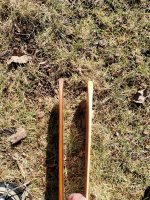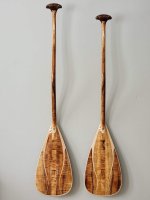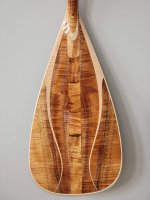I wish there were solid wood paddles and shelves to hold them in my part of the world!Been using a Grey Owl Tripper in oiled cherry for the last 20 some years. It’s been everywhere, lost count of the miles on it. Made a bunch and bought a few others paddles but always use the Tripper In the flat stuff. I don’t think the quality of wood is as good these days as it was when my original Grey Owl was built, the solid wood paddles I see on store shelves is hit and miss.
-
Happy International Tea Day! 🫖🍵
You are using an out of date browser. It may not display this or other websites correctly.
You should upgrade or use an alternative browser.
You should upgrade or use an alternative browser.
Wood paddles - which style and maker do you like?
- Thread starter kbobb
- Start date
My absolute favorite is my Bruce Smith Ottertail. I enjoy my Fishell, but the Smith feels so right when I switch back to it. Being that I paddle in shallow water so often, I wonder if Bruce would make me a shallow water paddle…
He might if he had a blade pattern. When Brad Gillespie agreed to make me a custom straight shaft paddle, he requested that I send him a cardboard pattern of the exact blade shape I wanted. I did so, using one of my favorite other paddles as my starting point.
Consider the paddle maker's point of view. They may not want to risk making an experimental paddle that the customer doesn't like and will bad mouth. Even if you give precise dimensions, the shape could vary. So, if the maker builds to an exact pattern, there will be less likelihood of mistakes, misunderstandings and disappointments.
However, maybe Bruce would simply agree to alter the shape of his Tripper 26 (x6) to something like a Tripper 20 (x7).
On the other hand, Bruce seems plenty busy with his current set of blade shapes. But it can't hurt to ask. He's gotten a lot of business and good publicity from several members of this site, which could be pointed out to him if he's not aware.
He might if he had a blade pattern. When Brad Gillespie agreed to make me a custom straight shaft paddle, he requested that I send him a cardboard pattern of the exact blade shape I wanted. I did so, using one of my favorite other paddles as my starting point.
Consider the paddle maker's point of view. They may not want to risk making an experimental paddle that the customer doesn't like and will bad mouth. Even if you give precise dimensions, the shape could vary. So, if the maker builds to an exact pattern, there will be less likelihood of mistakes, misunderstandings and disappointments.
However, maybe Bruce would simply agree to alter the shape of his Tripper 26 (x6) to something like a Tripper 20 (x7).
On the other hand, Bruce seems plenty busy with his current set of blade shapes. But it can't hurt to ask. He's gotten a lot of business and good publicity from several members of this site, which could be pointed out to him if he's not aware.
I also considered getting a tripper and cutting down the blade myself. It’s worth an email to him.
Glenn,
John is a pretty good guy, and his paddles really are top notch, no way he is making much on them. I buy unfinished, wood burn a phrase or two, stain ( sometimes) then oil and off I go. I like the handles as I utilize both top and side grip on long paddle days. They are great for the J or Guide stroke when I solo my tandems.
his tumplines are very good as well. I own 3 of them.
John is a pretty good guy, and his paddles really are top notch, no way he is making much on them. I buy unfinished, wood burn a phrase or two, stain ( sometimes) then oil and off I go. I like the handles as I utilize both top and side grip on long paddle days. They are great for the J or Guide stroke when I solo my tandems.
his tumplines are very good as well. I own 3 of them.
I wish I didn’t have to endure -30 winters, I’ll trade ya!I wish there were solid wood paddles and shelves to hold them in my part of the world!
Those Bruce Smith paddles look real nice. Somewhere between the classic and the beaver tail would be just about perfect.
I picked up my most recent Mitchell from Peter at his house and remember from conversation that his wife was a world or national caliber mountain biker and it was one of his passions as well. That would have been 2018. Looks like, as mentioned above, he has gone into the bike biz.That's too bad. The business never seemed to flourish as much under the son, Peter, after his parents, David and Peggy, both world champion slalom racers, retired in 2005. I used to visit David and Peggy about every other year in the 80's on my way to or from our family cottage in Maine. Got tours of the shop and Peggy was always so helpful over the phone. Here is a 2012 article on the Mitchell family:

Olympic Kayak Paddles Made in New Hampshire: A Family Legacy
Earlier this week, at the London Olympics, the American team competed in the double canoe slalom. That’s when two men kneel inside a kayak and work…www.nhpr.org
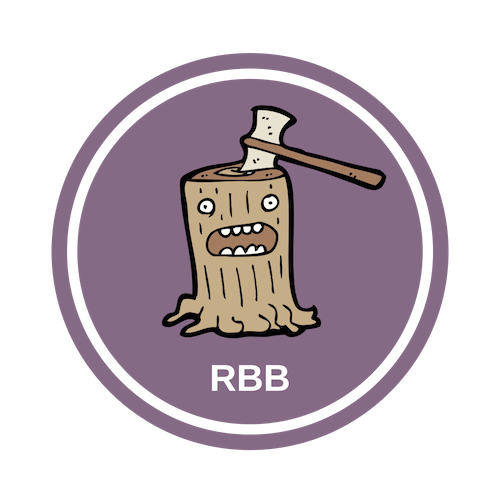
Rootball Bikes/Wooden Bike Frames
Rootball Bikes specializes in building bike frames from wood. Designed and built by Peter Mitchell of Mitchell Paddles.
Below are some comparative shots of several solid wood paddles on the market today and discussed above. From left to right:
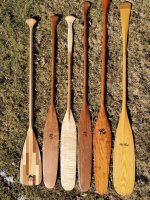
The Bending Branches Catalyst is just there for comparison, but I'd put it in a different class from the solid wood paddles. I love the super durability of the BB with it's glassed blade and rockguard edge, and the sustainability of the Catalyst model in particular. I got that for shallow water rock gardens and swamp stumping. I'll say it actually works decently for an underwater return stroke given it's shape.
The Fishell is definitely the beefiest of all the solid woods, as shown by the weight. The shaft and blade edges are all much thicker, and I'm very comfortable punting with it, but I tend to leave it home since it is so heavy (doesn't help that I bought it first, and it's really too long for me to use effectively in solo paddling). I think my favs are the Bruce Smith and Badger Tripper. The Sliver is nice for sunset toodling, but feels under-powered at times, and can have slight flutter on an underwater return if not pitched right. The Old Town, despite being heavier in both beefiness and wood choice, actually paddles really very nicely, and I'm comfortable using it across a range of conditions including shallow water, especially since it already had some abuse when I got it, including a crack I patched before recoating the varnish. I do really like the guide grip on it. The Badgers and Bruce Smith blades are wonderfully thin at the edge compared to the Fishell, which is great for underwater returns. The tip of Bruce's swells notably for protection against splitting against rocks....but it's so pretty I refuse to touch anything but water with it so far. Bruce says he build them for tripping though. Unlike some really cheap wood paddles I've seen, all of these quality paddle blades are thinnest about two thirds of the way down and swell a bit at the tip for reducing cracking risk.
I tried to get some comparative blade thickness shots, but it's tough to get two blades exactly straight on to the camera and in focus at the same time. Fishell vs Bruce Smith.
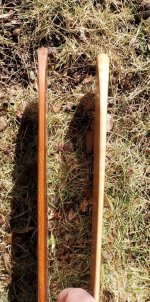
Badger Tripper vs Bruce Smith
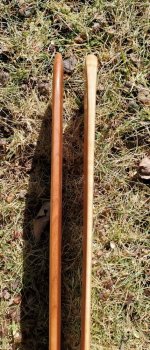
Old Town vs Bruce Smith
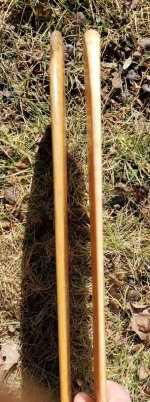
Catalyst vs Bruce Smith
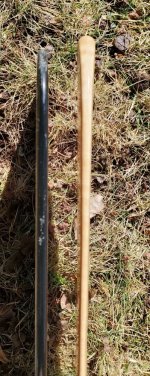
Grips are so personal I won't comment, but you can see the variation. Interestingly my two Badgers should have had the same grip style, but are noticeably different, with the Sliver being a bit more bulbous. You can tell each paddle is made by a person, not a robot (true for all these makers). I'll also note that the Badgers have darkened noticeably since purchase (only a couple years); the Fishell, which is varnished not oiled, has kept more of the redness of color in the cherry over 5 yrs - I guess varnish has better UV protection than oil.

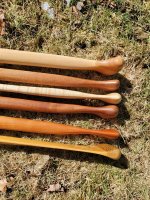
Setting aside the harder to procure ash paddles (though I'll be looking into both the BarkCanoe.com and Porter options since I like the Old Town so much), I think the Badgers are a nice buy for the money. In the States you can order them from Rutabaga (WI) or Collinsville Canoe & Kayak (CT). Bruce's paddles are really works of art. The Fishells are also gorgeous but beefier than my taste these days, especially for deep-water paddling.
- Bending Branches Catalyst straight-shaft. 56in total length; blade 19 x 8.1in (118 sq in); 24oz
- Badger Tripper. 57in; blade 28.5 x 5.5 (124.75 sq in); 25oz in cherry
- Bruce Smith Classic. 57in; blade 26.75 x 5.25; 25.6oz in curly maple with cherry shaft laminate. (I ordered a 58" from Bruce, but it was a custom paddle and came in a little short for some reason - maybe the curly maple he could get).
- Badger Sliver. 60in; blade 29.5 x 4.75 (113 sq in); 25oz in cherry
- Fishell Modified Otter. 62in; blade 28 x 5.5in; 34oz in cherry.
- Old Town (probably Porter-made, bought off Craigslist) with guide grip. 59in; blade 27.5 x 6.5. 29.5oz in ash.

The Bending Branches Catalyst is just there for comparison, but I'd put it in a different class from the solid wood paddles. I love the super durability of the BB with it's glassed blade and rockguard edge, and the sustainability of the Catalyst model in particular. I got that for shallow water rock gardens and swamp stumping. I'll say it actually works decently for an underwater return stroke given it's shape.
The Fishell is definitely the beefiest of all the solid woods, as shown by the weight. The shaft and blade edges are all much thicker, and I'm very comfortable punting with it, but I tend to leave it home since it is so heavy (doesn't help that I bought it first, and it's really too long for me to use effectively in solo paddling). I think my favs are the Bruce Smith and Badger Tripper. The Sliver is nice for sunset toodling, but feels under-powered at times, and can have slight flutter on an underwater return if not pitched right. The Old Town, despite being heavier in both beefiness and wood choice, actually paddles really very nicely, and I'm comfortable using it across a range of conditions including shallow water, especially since it already had some abuse when I got it, including a crack I patched before recoating the varnish. I do really like the guide grip on it. The Badgers and Bruce Smith blades are wonderfully thin at the edge compared to the Fishell, which is great for underwater returns. The tip of Bruce's swells notably for protection against splitting against rocks....but it's so pretty I refuse to touch anything but water with it so far. Bruce says he build them for tripping though. Unlike some really cheap wood paddles I've seen, all of these quality paddle blades are thinnest about two thirds of the way down and swell a bit at the tip for reducing cracking risk.
I tried to get some comparative blade thickness shots, but it's tough to get two blades exactly straight on to the camera and in focus at the same time. Fishell vs Bruce Smith.

Badger Tripper vs Bruce Smith

Old Town vs Bruce Smith

Catalyst vs Bruce Smith

Grips are so personal I won't comment, but you can see the variation. Interestingly my two Badgers should have had the same grip style, but are noticeably different, with the Sliver being a bit more bulbous. You can tell each paddle is made by a person, not a robot (true for all these makers). I'll also note that the Badgers have darkened noticeably since purchase (only a couple years); the Fishell, which is varnished not oiled, has kept more of the redness of color in the cherry over 5 yrs - I guess varnish has better UV protection than oil.


Setting aside the harder to procure ash paddles (though I'll be looking into both the BarkCanoe.com and Porter options since I like the Old Town so much), I think the Badgers are a nice buy for the money. In the States you can order them from Rutabaga (WI) or Collinsville Canoe & Kayak (CT). Bruce's paddles are really works of art. The Fishells are also gorgeous but beefier than my taste these days, especially for deep-water paddling.
Attachments
Thanks all for the replies - very helpful information and photos and I much appreciate the contact info. Having never had a solid wood paddle before it seems that maintenance - oil and varnish - are key to keeping it from warping and splitting. Any other thoughts regarding solid vs laminate?
I do tend to lean on my paddles when getting out of the boat so the tip does set on the lake shore.
I do tend to lean on my paddles when getting out of the boat so the tip does set on the lake shore.
Caleb Davis Tremolo branded cherry ottertail. Edges are thinned for slicing. Tip is splined for strength. 10% varnish, 90% oil mix on grip and shaft. Reverse ratio on blade. I have a bunch of them.'nuf said.
Any other thoughts regarding solid vs laminate?
Solid paddles are made from hardwoods and are usually long, skinny "tail" paddles, such as beavertail, ottertail, badgertail. Laminated paddles usually include softwoods such as cedar or basswood—and hence should be able to be made slightly lighter than hardwood paddles—and are more of a rectangular Sugar Island or Honey Island shape. Laminated paddles often have tip or edge protection made of some sort of resin and perhaps a fabric like Dynel.
Because of their squatter shape and protective edging, laminated paddles are probably more generally useful in all waters, including shallow and rocky waters, than hardwood tail paddles, whereas many paddlers prefer tail paddles for deep water cruising.
I find many inexpensive tail paddles to be too heavy, too blade thick, and much too blade heavy to be properly balanced. Some blades split too easily if the grain is not sawn properly or if shaved too thin. That's why a Bruce Smith paddle, for example, carries a premium price: he will choose proper grain sawn wood stock, hand sculpt to get the lightest weight possible for the particular wood, balance the shaft and blade properly, and swell the paddle tip to reduce splitting there. You can see his tip swell in Tsuga8's photos above.
Glenn's comments are spot on. I've heard Shaw and Tenney rejects boards at a very high rate too (something like 1 board of 10 gets used for a paddle?) - a skilled maker can read the wood grain for weakness.
Regarding leaning on the paddle while getting out, with a laminated paddle with an edge guard, spline, or similar, it should be no problem. For a solid hardwood, proper maintenance should keep it from being an issue. I'll quote Glenn from another thread quoting Bruce Smith (Bruce sends a paper sheet with this advice when you buy from him):
While that might not be necessary for every paddle, it's especially important for more open grain woods like maple and ash (and sassafras I think), and important for thinner blades. A friend with a Ray Kettelwell paddle, precursor to Fishell, and with a decently thick blade in cherry, got away with a raw end for years before it finally split. I don't hesitate to push off with my Fishell, but I do touch up the tip with varnish every couple years. Again, a good paddle is made to be used with reason and purpose (e.g. a deep water paddle isn't meant to be used in rocky streams, but an occassional lean should be fine).
@kbobb I think none of us asked what use you have in mind for said paddle beyond deep water and day paddles. American freestylers tend to like, from what I hear, a wider, shorter blade while Canadian soloists tend to like a really long skinny one. If you're looking to work on a particular style, different shapes may be better for that. Likewise some folks like a big blade for big powerful strokes, others prefer a smaller blade area for easier paddling with less force on joints, or a short stroke at a faster cadence. There's also the durablity vs weight trade-off. I was surprised at how nice my craigslist Old Town performed, but I suspect it was made long ago of hardwood and is nice quality (thin but not too thin blade, good balance). In the same deal I got another Old Town that's similar, but it's a little heavier with a wider blade and no guide grip, and the balance isn't quite right - it's good, but not great.
What don't you like about the Old Town beavertail you mentioned in your OP?
Regarding leaning on the paddle while getting out, with a laminated paddle with an edge guard, spline, or similar, it should be no problem. For a solid hardwood, proper maintenance should keep it from being an issue. I'll quote Glenn from another thread quoting Bruce Smith (Bruce sends a paper sheet with this advice when you buy from him):
"If you look closely, you will see that I am soaking the tip of my black cherry modified Ottertail on the right. I am using about 80% boiled linseed oil mixed with 20% varsol or mineral spirits. The latter helps the oil penetrate better....deep into the cells. This routine about every 3 years for 4 or 5 days gives you a permanent water seal in the wood fibre at the tip. This keeps water out and prevents the wet/dry or expansion/contraction cycle that often leads to cracks at the tip. An old timer taught me this when I worked at the Ontario Camp Leadership in 1972.......been using this trick ever since."
While that might not be necessary for every paddle, it's especially important for more open grain woods like maple and ash (and sassafras I think), and important for thinner blades. A friend with a Ray Kettelwell paddle, precursor to Fishell, and with a decently thick blade in cherry, got away with a raw end for years before it finally split. I don't hesitate to push off with my Fishell, but I do touch up the tip with varnish every couple years. Again, a good paddle is made to be used with reason and purpose (e.g. a deep water paddle isn't meant to be used in rocky streams, but an occassional lean should be fine).
@kbobb I think none of us asked what use you have in mind for said paddle beyond deep water and day paddles. American freestylers tend to like, from what I hear, a wider, shorter blade while Canadian soloists tend to like a really long skinny one. If you're looking to work on a particular style, different shapes may be better for that. Likewise some folks like a big blade for big powerful strokes, others prefer a smaller blade area for easier paddling with less force on joints, or a short stroke at a faster cadence. There's also the durablity vs weight trade-off. I was surprised at how nice my craigslist Old Town performed, but I suspect it was made long ago of hardwood and is nice quality (thin but not too thin blade, good balance). In the same deal I got another Old Town that's similar, but it's a little heavier with a wider blade and no guide grip, and the balance isn't quite right - it's good, but not great.
What don't you like about the Old Town beavertail you mentioned in your OP?
Glen and Tsuga - great info - thanks
The old town paddle I had was a laminated beavertail with edge guard from a big box store - it was a little heavy but I liked it fine since I didn't feel bad about using it hard. I stupidly left it at a lake last month. Thought I'd upgrade my straight shaft paddle since I'm now in the market for one.
I will only be using the paddle for day trips and fishing on lakes - no interest in free style stuff, whitewater/rivers, or multiday trips.
The old town paddle I had was a laminated beavertail with edge guard from a big box store - it was a little heavy but I liked it fine since I didn't feel bad about using it hard. I stupidly left it at a lake last month. Thought I'd upgrade my straight shaft paddle since I'm now in the market for one.
I will only be using the paddle for day trips and fishing on lakes - no interest in free style stuff, whitewater/rivers, or multiday trips.
@kbobb I'd say if you can try out paddles, that's your best bet. Second to that is if you can at least lay hands on them in a store. I think lots of the paddles mentioned here are fine products, and part of it will come down to weight/durability/cost/use/aesthetic calculations, but there's no substitute for getting the individual piece of wood in your hands. As evidenced by the grips on my two Badgers, there's individual variation in pieces of wood being hand-shaped by humans.
Bending Branches and Badger post the square inch surface areas of their paddles, which is helpful, but you really don't get a feel for how blade shape and area affect things until you start using the paddle. A paddle might have all the right stats, but still not quite feel right in your hands.
Depending on where you're located, a forum member (myself included) might be willing to let you try a few ottertails before you buy. Also, at the end of the day, all these paddles will paddle just fine and probably last a very long time.
Bending Branches and Badger post the square inch surface areas of their paddles, which is helpful, but you really don't get a feel for how blade shape and area affect things until you start using the paddle. A paddle might have all the right stats, but still not quite feel right in your hands.
Depending on where you're located, a forum member (myself included) might be willing to let you try a few ottertails before you buy. Also, at the end of the day, all these paddles will paddle just fine and probably last a very long time.
Last edited:
Quimby. Second: Dogpaddle.
Wow, very cool! What type of wood is that?
Looks like Koa to me. They are beautiful.
Jim
Jim
Yes, curly koa.Looks like Koa to me. They are beautiful.
Jim
Here are some impressive paddles, made by Philip Greene (via Facebook)
Here is more of Phil Greene's work:
The Most Expensive Canoes and Paddles in the World
I went off on a tangent in the adjustable sliding seat thread to show off some of Phil Greene's stunning Wood Song canoes. There is a whole page of his masterpieces on ETSY, in addition to the website and Facebook links I provided in the other thread. Here is likely the most expensive solo...
www.canoetripping.net
I had forgotten that post. I may have seen one of his canoes in Charleston some years back. It was not in the water.
Similar threads
- Replies
- 55
- Views
- 5K
- Replies
- 56
- Views
- 6K

